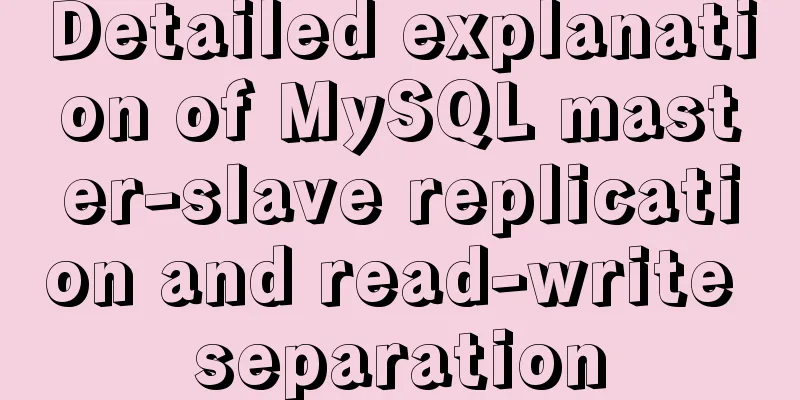Detailed explanation of MySQL master-slave replication and read-write separation

PrefaceIn actual enterprise applications, mature businesses usually have large amounts of data, and a single MySQL server cannot meet actual needs in terms of security, high availability, and high concurrency. We can deploy master-slave replication on multiple MySQL servers (Master-Slave) to synchronize data, and then improve the concurrent load capacity of the database through read-write separation. It is somewhat similar to rsync, but the difference is that rsync backs up disk files, while MySQL master-slave replication backs up data and statements in the database. 1. OverviewMaster-slave replication: The master database (Master) sends update events to the slave database (Slave), which reads the update records and executes them to keep the contents of the slave database consistent with the master database. 1. Replication types supported by MySQL
(II) Working process of MySQL master-slave replication
1.Master server saves records to binary log
2. The slave server copies the log of the master server
3. The slave server replays the copied logs
Important: The replication process has a very important limitation, that is, replication is serialized on the Slave, which means that parallel update operations on the Master cannot be performed in parallel on the Slave. 2. Read-write separation(1) The concept of read-write separation Read-write separation: Read-write separation means writing only on the master server and reading only on the slave server. The basic principle is to let the master database handle transactional addition, modification, and deletion operations (INSERT, UPDATE, DELETE), while the slave database handles SELECT query operations. Database replication is used to synchronize changes caused by transactional operations to slave databases in the cluster. (2) The role of read-write separation
(3) MySQL read-write separation principle
(4) Common MySQL read-write separation 1) Based on internal implementation of program code 1. Classify routes according to select and insert in the code. This method is also the most widely used in production environments. 2. Advantages and disadvantages:
3. Not all applications are suitable for implementing read-write separation in program code. For example, for some large and complex Java applications, implementing read-write separation in program code will require significant code changes. 2) Implementation based on the intermediate proxy layer 1. The proxy is usually located between the client and the server. After receiving the client request, the proxy server forwards it to the backend database after judgment. The following are representative programs:
2. Since using MySQL Proxy requires writing a large number of Lua scripts, these Lua scripts are not ready-made and need to be written by yourself, which is very difficult for people who are not familiar with MySQL Proxy built-in variables and MySQL Protocol. 3.Amoeba is a very easy-to-use and highly portable software, so it is widely used as the proxy layer of the database in production environments. 3. MySQL master-slave replication experimental deployment Required related software package
(1) Master-slave replication experimental steps and preparation Experimental steps Step 1: Client client accesses proxy server amoeba
1. Turn off firewall and security mechanisms All four servers must be shut down systemctl stop firewalld systemctl disable firewalld setenforce 0 2. Install the time synchronization service ntp (1) Primary Server yum -y install ntp vim /etc/ntp.conf ##---------Add at the end--------- server 127.127.71.0 #Set the local clock source, pay attention to modify the network segment fudge 127.127.71.0 stratum 8 #Set the time level to 8 (limited to 15) service ntpd start
(2) Two slave servers yum -y install ntp ntpdate service ntpd start /usr/sbin/ntpdate 192.168.71.12 #Time synchronization, pointing to the Master server IP crontab -e #Set the scheduled task to synchronize the time every half an hour */30 * * * * /usr/sbin/ntpdate 192.168.71.12
3. MySQL configuration of the main server vim /etc/my.cnf server-id = 1 log-bin=master-bin #Add, master server opens binary log log-slave-updates=true #Add, allow slave server to update binary log systemctl restart mysqld mysql -u root -p grant replication slave on *.* to 'myslave'@'192.168.71.%' identified by '123'; #Elevate privileges to the slave server #grant authorization #replication replication #Allow the network segment 192.168.71 to use password 123 to replicate all tables and libraries flush privileges; show master status; #The File column shows the log name, and the Fosition column shows the offset
4. MySQL configuration from the server Slave1 server: 192.168.163.13 1) Modify the configuration file vim /etc/my.cnf #Modify, note that the id is different from the Master, and the ids of the two Slaves must also be different server-id = 2 #Add, open relay log, synchronize log files from the master server to the local relay-log=relay-log-bin #Add, define the location and name of the relay log file relay-log-index=slave-relay-bin.index systemctl restart mysqld slave1
slave2
2) Operate the database from the server mysql -u root -p123 change master to master_host='192.168.71.12',master_user='myslave',master_password='123',master_log_file='master-bin.000002',master_log_pos=306; #show master status; The output binary file is the same as the position point #Configure synchronization, note that the values of master_log_file and master_log_pos must be consistent with the Master query start slave; #Start synchronization, if there is an error, execute reset slave; show slave status\G; #Check the slave status // Make sure that both IO and SQL threads are Yes, indicating that the synchronization is normal. Slave_IO_Running:Yes #Responsible for io communication with the host Slave_SQL_Running:Yes #Responsible for its own slave mysql process
5. Verify the results Create a library on the master server and view it on the slave server
4. MySQL read-write separation experiment Amoeba Server (192.168.153.30) 1) Create a jdk java environment cd /opt/ #Upload jdk-6u14-linux-x64.bin and amoeba-mysql-binary-2.2.0.tar.gz to the /opt directory cp jdk-6u14-linux-x64.bin /usr/local/ cd /usr/local/ chmod +x jdk-6u14-linux-x64.bin ./jdk-6u14-linux-x64.bin //Press yes, press enter mv jdk1.6.0_14/ /usr/1ocal/jdk1.6 vim /etc/profile export JAVA_HOME=/usr/local/jdk1.6 export CLASSPATH=SCLASSPATH:$JAVA_HOME/lib:$JAVA_HOME/jre/lib export PATH=$JAVA_HOME/lib:$JAVA_HOME/jre/bin/:$PATH:$HOME/bin export AMOEBA_HOME=/usr/local/amoeba export PATH=$PATH:$AMOEBA_HOME/bin source /etc/profile java -version
2) Install Amoeba software mkdir /usr/local/amoeba tar zxvf /opt/amoeba-mysql-binary-2.2.0.tar.gz -C /usr/local/amoeba/ chmod -R 755 /usr/local/amoeba/ /usr/local/amoeba/bin/amoeba //If amoeba start|stop is displayed, it means the installation is successful
3) Authorize on the mysql of the master and slave servers Master server: 192.168.71.12 First, open permissions on the mysql of Master, Slave1, and Slave2 for Amoeba to access grant all on *.* to 'test'@'192.168.163.%' identified by 'abc123';
4) Configure amoeba service on amoeba cd /usr/local/amoeba/conf/ cp amoeba.xml amoeba.xml.bak #Backup the configuration file vim amoeba.xml #Modify the amoeba configuration file <property name="user">amoeba</property> #Modify line 30 <property name="password">abc123</property> #Modify the password for the client to connect to the amoeba server on line 32 <property.name="defaultPool">master</property> #Modify the default pool on line 115 <property name="writePool">master</property> #Remove comments on line 117 and set master as the write pool <property name="readPool">slaves</property> #slaves as the read pool
cp dbServers.xml dbServers.xml.bak vim dbServers.xml #Modify the database configuration file<!-- <property name="schema"> test</property> --> #Line 23, comment out the purpose: enter the test library by default in case there is no test library in mysql, an error will be reported<property name="user">test</property> #Line 26, modify the user and password for privilege escalation on the master and slave servers<property.name-"password">123</property> #Lines 28-30, remove the comments<dbServer name= "master" parent="abstractServer"> #Line 45, modify, set the name of the master server to Master <property name= "ipAddress">192.168.71.12</property> #48 line, modify, set the address of the master server <dbServer name="slave1" parent="abstractServer"> #52 line, modify, set the name of the slave server slave1 <property.name="ipAddress">192.168.71.13</property> #55 line, modify, set the address of slave server 1 <dbServer name="slave2 " parent="abstractserver"> #59 line, copy and paste the above 6 lines, set the name and address of slave server 2 slave2 <property, name="ipAddress">192.168.71.14</property> <dbServer name="slaves" virtual="true"> #65 line, modify <property name="poolNames">slave1,slave2</property> #71 line, modify /usr/local/amoeba/bin/amoeba start& #Start Amoeba software, press ctrl+c to return netstat -anpt | grep java #Check whether port 8066 is open, the default port is TCP 8066
5) Test read-write separation Testing on the client server yum install -y mysql mysql-server #Quickly install mysql, or you can choose to compile and install mysql -u amoeba -pabc123 -h 192.168.71.20 -P8066
This table can be seen on both the master and slave servers.
Access MySQL through the amoeba server proxy. After connecting to MySQL through the client, the data written will only be recorded by the master service and then synchronized to the slave server.
stop slave; #Close synchronous writing of data use school;
//On slave1:
insert into test1 values('1','slave1');
//On slave2:
insert into test1 values('2','slave2');
Insert data on the primary server
insert into test1 values('3','master');Insert data into the table in the client
//On the client server:
use school;
select * from test1; //The client will read data from slave1 and s1ave2 respectively, and only the data added on the two slave servers will be displayed, and no data added on the master server will be displayed insert into test1 values('4','climet'); //This data is only available on the master server
View data on the primary server
Start two slave servers at the same time and view the table records
This is the end of this article about MySQL master-slave replication and read-write separation. For more relevant MySQL master-slave replication and read-write separation content, please search for previous articles on 123WORDPRESS.COM or continue to browse the following related articles. I hope everyone will support 123WORDPRESS.COM in the future! You may also be interested in:
|
<<: Using JS to implement binary tree traversal algorithm example code
Recommend
Share the pitfalls of MySQL's current_timestamp and their solutions
Table of contents MySQL's current_timestamp p...
How to use Dayjs to calculate common dates in Vue
When using vue to develop projects, the front end...
Teach you how to write maintainable JS code
Table of contents What is maintainable code? Code...
Vue uses openlayers to load Tiandi Map and Amap
Table of contents 1. World Map 1. Install openlay...
Detailed examples of Linux disk device and LVM management commands
Preface In the Linux operating system, device fil...
Summary of Linux file basic attributes knowledge points
The Linux system is a typical multi-user system. ...
How to use SessionStorage and LocalStorage in Javascript
Table of contents Preface Introduction to Session...
How to handle spaces in CSS
1. Space rules Whitespace within HTML code is usu...
How can MySQL effectively prevent database deletion and running away?
Table of contents Safe Mode Settings test 1. Upda...
A few front-end practice summaries of Alipay's new homepage
Of course, it also includes some personal experien...
Problems encountered when installing mysql8.0.15 winx64 on Win10 and connecting to the server
1. Download, install and configure mysql-8.0.15 1...
Summary of some points to note when registering Tomcat as a service
Here are some points to note when registering Tom...
JS uses map to integrate double arrays
Table of contents Preface Simulating data Merged ...
Preventing SQL injection in web projects
Table of contents 1. Introduction to SQL Injectio...
MySQL 5.7.17 winx64 installation and configuration tutorial
Today I installed the MySQL database on my comput...






































